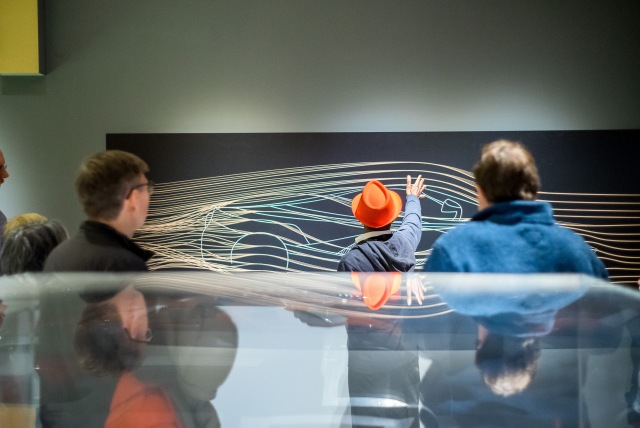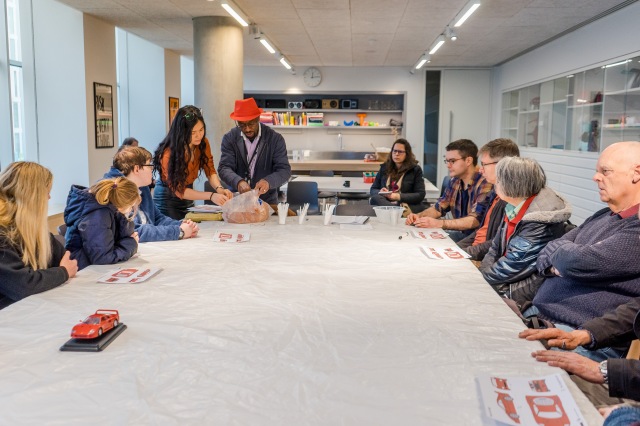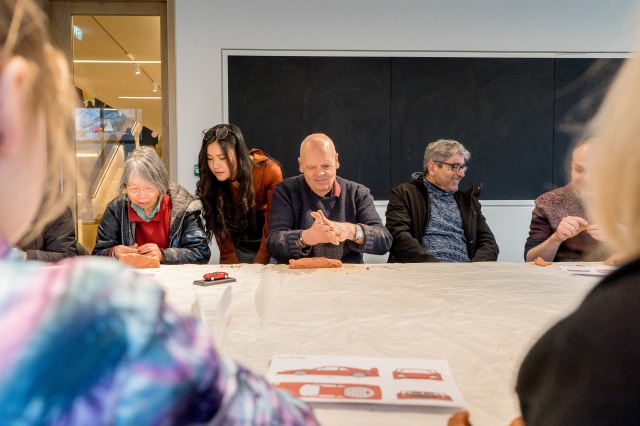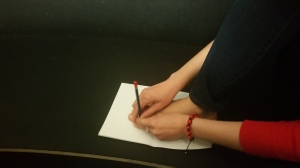Venue: The Design Museum, London
Date: Saturday 17 March 2018

Image: Visually impaired participants can be seen exploring samples of upholstery materials used in the making of Ferrari car seats.
The Tour
The FERRARI: UNDER THE SKIN exhibition commemorates Ferrari’s 70-year history and explores Enzo Ferrari’s inspirations, original photography, hand written letters, original drawings, and some cars from this iconic car brand. This tour for visually impaired visitors was an excellent opportunity to understand Enzo’s inspirations and to see the design and development processes that went into creating some truly remarkable cars.
The exhibition is dedicated to detailing the remorseless drive of Enzo Ferrari to create the perfect driving machine for track and road. There are 14 cars in this exhibition and our road map was to focus on a few models that carry a distinctive thread through the Ferrari history, allowing us to discover Enzo Ferrari’s passion and the continuing development of the Ferrari brand.
We looked at the 125S, the F40, an original 1:1 scale model of the J50, and the LaFerrari Aperta. This tour was also unique as we were able to deliver two tours on the same day, a testament to the popularity of the Ferrari exhibition.

Image: Ferrari 125 S | Image Credit: Design Museum
The 125 S was the first Ferrari, an extraordinary achievement in an Italian economy devastated by the 2nd world war. This is the only existing official replica, built in 1987.
FerrariFact – Enzo Ferrari was 49 years old when this car was created.

Image: Clay Model of the Ferrari J50 | Image Credit: Design Museum
Displayed here is an original 1:1 scale hand-crafted clay design model of the J50 which was made in 2016 in a run of only 10 cars to celebrate 50 years of Ferrari in Japan.
Experimenting with special modelling clay was first discovered in the United States in the 1920’s. Unlike normal clay, the water phase of the material was replaced with waxes and oils so that it remained soft enough to work with but firm enough to keep its form, an essential property which meant it did not dry out or harden too quickly.
The clay is initially built up more thickly than the dimensions given so the final shape is generated by a process of subtraction. Modellers continually work closely with the car designers, adjusting and appraising the car’s form as it develops.
An additional advantage of clay is that it is also possible to add material back on after it has been removed, so the process of creating a perfect car is both iterative and collaborative.

Image: Flow line visualisation | Credit: Design Museum
Wind tunnel testing is the traditional method for developing racing car aerodynamics. Tunnel testing helps to visualise airflow over the bodywork, providing design solutions that reduce drag. Potential flow instability issues can also be resolved as accurate modelling of real world track conditions can be mimicked, providing opportunities for design solutions that can bring high-speed stability.
Fine detailing of aero sensitive areas of the car can produce substantial gains in performance and the Ferrari full scale wind tunnel test facility in Maranello allows the aerodynamicist the best opportunity to fine-tune geometry without the worry of scale effects.

Image: Andrew can be seen describing the flow line visualisation

Image: Ferrari logo | Image Credit: Ferrari Corporate
The Ferrari logo with its iconic Prancing Horse symbolises Italian luxury, exclusivity, performance, design and quality the world over.
According to Enzo Ferrari, after he won the 1923 circuito del Savio in Ravenna, he met the famous Count Francesco Baracca, father of the world war 1 Italian ace pilot Francesco Baracca, who had died in 1918. Ferrari also met the pilot’s mum, Countess Paolina Baracca, who suggested that he should put on his cars the prancing horse that her son had used on the side of his plane, as she thought it would bring him luck.
The original “prancing horse” on Baracca’s airplane was painted in red on a white cloud-like shape, but Ferrari chose to have the horse in black. The black color signified the grief of Baracca’s squadron after the pilot was killed in action. Ferrari’s engineering department adapted the horse so that it balanced on one leg with its tail pointed upwards.
The letters S F (Scuderia Ferrari) was initially engraved at the bottom but by 1947 the letters S F had been replaced by the Ferrari name. Then Ferrari added a canary yellow background as this is the color of the city of Modena, his birthplace. The logo is crowned with green, white and red strips, which symbolize Italian national colors.
The font of this logo is stylish and effective, highlighting the brand features of the manufacturer.
The featured car, the Ferrari F40

Image: Ferrari F40 | Image Credit: Ferrari Corporate
The F40 was conceived as a special car to commemorate 40 years since the very first Ferrari – the 125 S. Enzo Ferrari suggested that the company did something special ‘the way we used to do’.
When the F40 was eventually announced in 1987 its Pininfarina designed body took everybody’s breath away. It was raw and mean, a car that looked like a racing model. The F40 model title was derived from “F” for Ferrari and 40 represented the fortieth anniversary of Ferrari car production. It was also the last new car presentation attended by Enzo Ferrari before his death in August 1988.

Image: Andrew describes the unique features of the F40 to several visually impaired participants. The image shows the rear of the car and it’s distinctive rear wing.

Image: LaFerrari Aperta in production | Image Credit: Design Museum
Designed for Ferrari’s most passionate clients, the LaFerrari Aperta is the new limited-edition special series model, and just 350 models of this spider version of the acclaimed LaFerrari supercar will be built.
This hybrid combines an electric motor and battery system to give a striking performance boost as well as a reduction in fuel consumption. The LaFerrari displayed in this exhibition is a white one. We normally associate all Ferraris with their trademark red colour, called “Rosso Corsa”, but buyers nowadays have a multitude of different finishes to choose from.
The workshop session.
For the workshop session, the Ferrari F40 was our model of choice. Workshop participants were able to take some of the ideas and thoughts from the tour into this session. We also had vector drawings and a 1:18 scale model to help with our attempts to create clay models of the F40.
Understanding how to convert drawings, the 2D phase of design, into more complex 3D one is key to judging volume and proportions on a real model. It is also useful for determining the car’s surfaces and for the insertion of fine details like the lights, doors and rear wing.
We were able to create a good number of clay models which looked great, especially as many were made by first-time clay modellers. We had tools like Surform blade, slicks and spatula to help clean up the surface but not really enough time to fully benefit from their use.
What was quite remarkable is the way all visually impaired participants were able to partake in the making process and how we could feel the surfaces and intersections in the clay models, observing the harmony of the shapes and the quality of the surfaces.

Image: Visually impaired participants at the creative workshop waiting for modelling clay to be used in the making session. Andrew is assisted by two sighted guides.

Image: A sighted guide and artist helps to mould the modelling clay into round palm size shapes.

Image: Another sighted guide helps Andrew prepare the modelling clay for the making session.

Image: Image: Visually impaired participants at the start of the workshop session.

Image: A visually impaired participant uses the 1:18 scale model of the Ferrari F40 as he makes his clay model at the workshop session.

Image: A visually impaired participant uses the large vector drawings to determine the scale and dimensions of his clay model Ferrari F40, at the workshop session.
Some Testimonials:
“A fascinating exhibition and fun activity after rounded off the event very well. The volunteers were excellent, and the guides were friendly and patient.” – Ema P.
“We were impressed with how much thought and preparation Andrew put into making the exhibition and its ideas accessible to the children.” – Peter W.
“The museum volunteers were excellent.” – Jessica B.
“Impressive!” – Mihay I.
Credits:
Tour Guide: Andrew Mashigo
Tour Programmer: Bernard Hay, Producer Adult Learning, Design Museum
Photography: Ryan Prince Art
Large Print Guide: MaMoMi
Copyright © 2018 The Design Museum. All Rights Reserved.
The next tour:
MULTISENSORY ARCHITECTURE TOUR
Saturday 12 May 2018
11:00 – 12:30
The sensory trail will stop at interesting features along a tour designed to explore specific physical features and a tactile walkway around and within the museum.
This is a free tour and early booking is advised.








